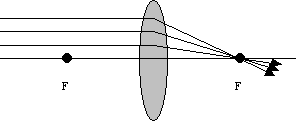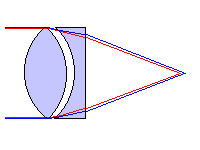
Light from distant objects comes in as parallel lines. The objective lens (or) primary lens bends (refracts) the light and brings it to a focus to form a small inverted image. A second lens, the eyepiece lens, then magnifies this inverted image. The light after passing through the telescope is more concentrated and the image magnified. In the design above, the mirror serves no purpose other than to make the telescope easier to use.
|
How does a lens work? Parallel rays of light arrive at a lens from an object a great distance away and refract as they pass through the lens. A properly shaped lens causes the light to converge at the focal point. The distance from the lens to the focal point is called the focal length. |

|
Chromatic Aberration
One pitfall of using refraction to bend light is, it will always
work as a prism: different colors of light bend at differing
angles through a lens. An Achromatic lens is able to bring
some of the light to the same focus.
 A normal lens bends all the light, but the focal length is wavelength dependent! Blue light converges sooner than red light. |
 An achromatic lens is made of two parts, the second lens can be designed to focus more of the light (though not all) to a single focal point. |